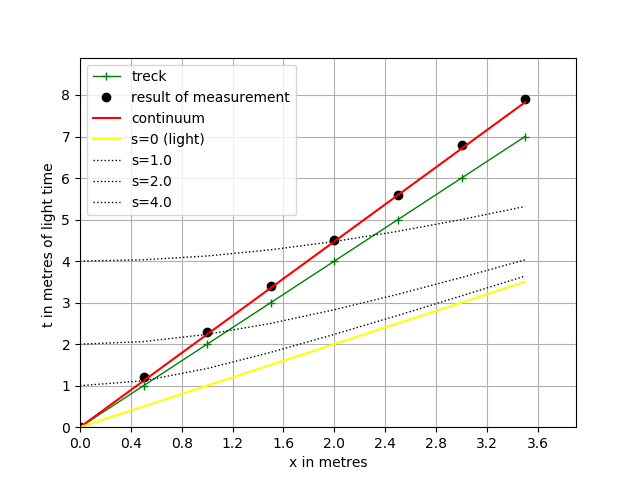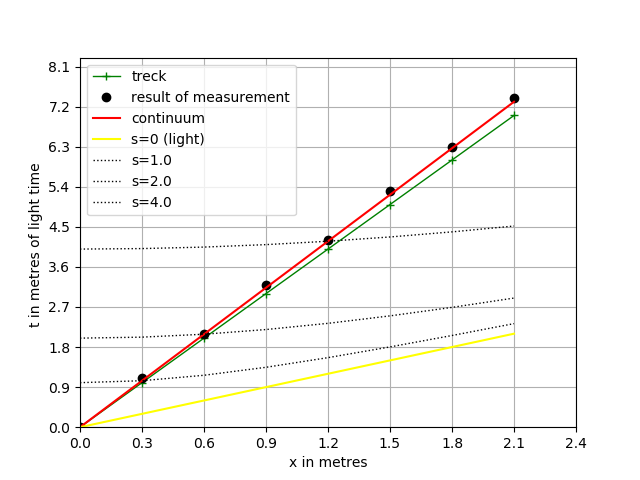pymms
Implementation of a non-numeric spacetime model with the Minkowski metric
View the Project on GitHub vgurianov/srt
1. Simulation model
• Use-Case Model• Analysis Model
• Design Model
2. Package API
• Package Overview• pymms.mms module
• pymms.resacher_instruments module
• pymms.print_results and pymms.drawing modules
3. Experiments
• Getting Started• The time dilation
• Velosity and energy as function of momentum
• Inertial reference frame
Time dilation
Module mms.experiment1 is simulated kinematic relativistic effects.
1. Experiment description
Estimated calculation for \(\pi ^+\) meson (pion):
Time we measure in metre of light time, i.e. \(3.335640 \times 10^{-9}\) seconds.
Lifetime is \( \tau_{0} = 2.6 \times 10^{-8} \) seconds or 7.8 metres of light time.
\(\beta = v/c = 0.5 \).
Moving pion has a longer decay time \( \tau = \frac{\tau_{0}}{\sqrt{1 -\beta ^2 }} = 3.0 \times 10 ^{-8}\) seconds or 9.0 metres of light time.
Distance \( d = c \times \beta \times \tau = 4.5 \) metres,
i.e. we must consider grid 10 x 10.
Parameters of experiment:
count_tick= 8, size_tick= 10
Particle_velosety= 5 ,i.e v/c = 0.5
Time count = 80
nu_t = 10.0 , nu_x = 10.0 , nu_m = 1.0
mass = 1 , lightVel = 1.0
2. Results of experiment
In table is depicted result of simulation.
Trajectory of particle and time of the particle
+----+-----+-----+------+------+-----+
| Tw | x | t | ta | err% | tp |
+----+-----+-----+------+------+-----+
| 0 | 0.0 | 0.0 | 0.0 | 0.0 | 0.0 |
| 1 | 0.5 | 1.2 | 1.12 | 7.33 | 1.0 |
| 2 | 1.0 | 2.3 | 2.24 | 2.86 | 2.0 |
| 3 | 1.5 | 3.4 | 3.35 | 1.37 | 3.0 |
| 4 | 2.0 | 4.5 | 4.47 | 0.62 | 4.0 |
| 5 | 2.5 | 5.6 | 5.59 | 0.18 | 5.0 |
| 6 | 3.0 | 6.8 | 6.71 | 1.37 | 6.0 |
| 7 | 3.5 | 7.9 | 7.83 | 0.94 | 7.0 |
+----+-----+-----+------+------+-----+
Column Tw is the number of tick of model time. Column x - is the coordinate of the particle in moment Tw. Column tp is the time of the particle. We can observe dilation of time. In the particle, tp units of time elapse, but, in the rest frame of reference t units of time are registered . Column ta is analytic calculation to formula \(ta = \sqrt{s^2+x^2}\) . Value ta compare with t
\[\begin{align*} \epsilon = \bigl| \frac{t_{a} - t}{t_{a}} \bigr| \times 100 % \\ \end{align*}\]It is column err%.
This result is depicted in Fig.1. Black “o” is the result of the measurement. The red line is analytical value.

Figure 1. Minkowski spacetime diagram for \(\beta = 0.5\)
We processing of data and calculate of incline k (green line)
Experimental error of measurement t is 0.05
Point couple method (d=4)
0 20 45 2.25
1 20 44 2.2
2 20 45 2.25
3 20 45 2.25
Couple count = 4
Measurement incline k_ar= 2.24
k_ar = 2.24 +/- 0.012
Analytical incline k_an= 2.24, k_err%= 0.12
In case of small velocity, plot depicted in Fig.2.

Figure 2. Minkowski spacetime diagram for \(\beta = 0.3 \)
3. Description of experiment1 modul
Class “FreeMotion”
Description: the class is a simulation model
Bases: mms.Composite
def __init__(self, size_tick, count_tick, particle_velosety, observer)
| Name | Type | Description |
|---|---|---|
| size_tick | int | size of time tact |
| count_tick | int | count of tacts |
| particle_velosety | int | inicial speed particle |
| observer | Table instance | Detector and recorder |
Operations:
def interaction(self, car) Description: none interaction Parameters: “car” is “Currer” instance
Class “OriginalToolkit”
Description: new procedures join to processor of data
Bases: ResacherInstruments.DataProcessing
def __init__(self, observer,particle_velosety, sizeTick, countTick)
| Name | Type | Description |
|---|---|---|
| observer | Table instance | Detector and recorder |
| particle_velosety | int | initial speed particle |
| size_tick | int | size of time tact |
| count_tick | int | count of tacts |
Operations:
def incline(self)
Description: incline k calculate and error
Parameters: None
Algorithm:
The analytical value of incline \(k_{an}\) can deduce from the formula of the invariant interval
\( s^2 = c^2t^2 - x^2 \)
Let \(t’\) be fix moment of time then distance be \(x = vt’ \).
We have \(s = ct’ \) if \(x = 0 \).
We obtain
\( ct = \sqrt{s^2 + x^2} = \sqrt{(cx/v)^2 + x^2} = x \sqrt{1 + c^2/v^2} \) .
The result is
\( a_{an} = \sqrt{1 + c^2/v^2} \)
The experiment data processing is
\( \Delta t_{i} = t_{i} - t_{i-4} \)
\( \Delta x_{i} = x_{i} - x_{i-4} \)
\( k_{ar} = \frac{1}{N}\sum_{i=4}^{n} \Delta t_{i} / \Delta x_{i} \),
wher N is count of couples.
The standard deviation is
\( sk_{ar} = \sqrt{\operatorname {Var}(k_{ar}) / (N-1)} \), where \(\operatorname {Var}(k_{ar}) \) is variance and N is count of pair.
The confidence interval is
\( dk_{ar} = sk_{ar}/\sqrt{N} \)
Then
\( k_{ar} = k_{ar} \pm dk_{ar} \)
Class “OriginalPrint”
Description: rewrite procedure xtPrintPrettyTable Bases: print_results.TablePrint